Adriana Lecouvreur, opera in four acts by Francesco Cilea. 1902. Libretto by Arturo Colautti, after the play Adrienne Lecouvreur by Eugène Scribe and Ernest Legouvé. First performance at the Teatro Lirico, Milan, on 6th November 1902.
As many opera fans have certainly noticed on numerous occasions, one of the little mysteries of our world is the phenomenon of operas which, sometimes absent from the stages for several years, suddenly become “fashionable” in a given season and appear simultaneously, or almost, on the billboard of numerous theaters.
Of course, we don’t claim to know exactly what’s happening in every theater of the world, but, looking in our immediate vicinity, between the end of 2021 and the first months of 2022, there were – in Italy alone – three different editions of Adriana Lecouvreur, as well as another revival of the same opera at the Vienna Staatsoper, in the classic staging David McVicar created for Covent Garden, and which was also the one performed at La Scala until a few days ago.
In addition to the Adriana Lecouvreur that we saw in Bologna and reviewed in late November, we happened to see two different editions of it in less than a week, one at La Scala on 12 March and then another one in Piacenza six days later. Therefore, it seemed natural to us to tell our readers about the two shows in the same article, since, in the mind of the reviewer, the comparison was immediate and spontaneous.
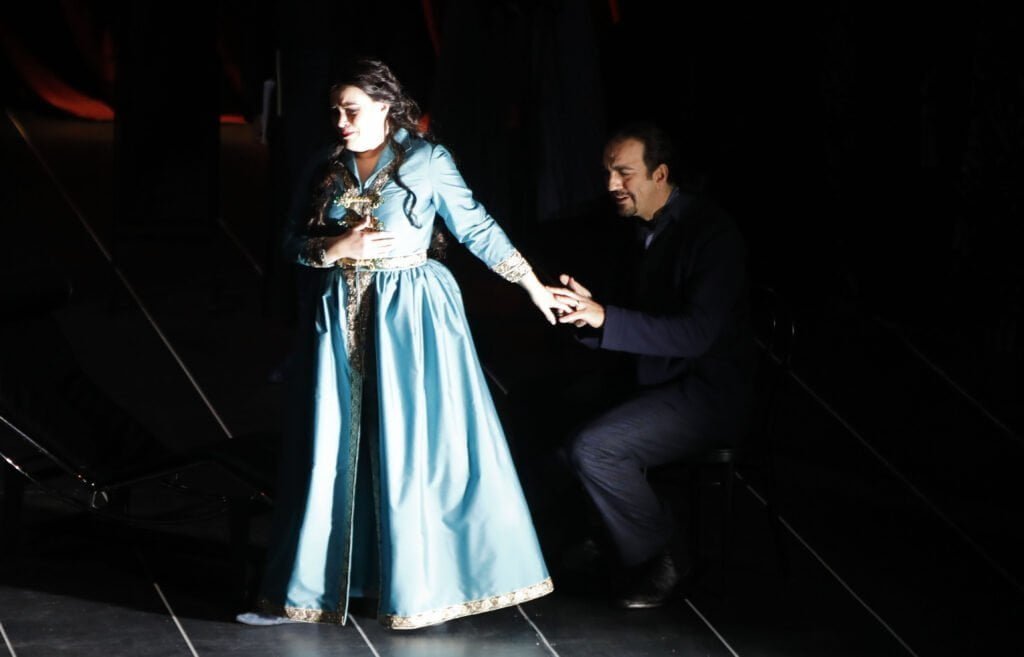
Let’s say right away that, as might be expected, we watched two quite different shows, in every sense. Both had, at least in our opinion, strengths and weaknesses, and considering all the elements, after having reflected at length on our impressions, we feel able to affirm that, if it were a question of judging a competition, we would be inclined to award an even match. Here we will try to explain our conclusion, starting with the part where the differences are most immediately evident, namely the direction / scenography.
David McVicar’s direction, chosen by La Scala, was staged for the first time in 2010 at the Royal Opera House. Since then, it has returned several times to numerous theaters and has now become a classic.
As he often does, also for this Adriana Lecouvreur, Sir David chooses to respect not only the story, but also the time of the action, and therefore the show. It makes use of the splendid costumes designed by Brigitte Reiffenstuel and develops following the libretto almost to the letter, albeit with a particular scenic setting, especially in the first and last act.
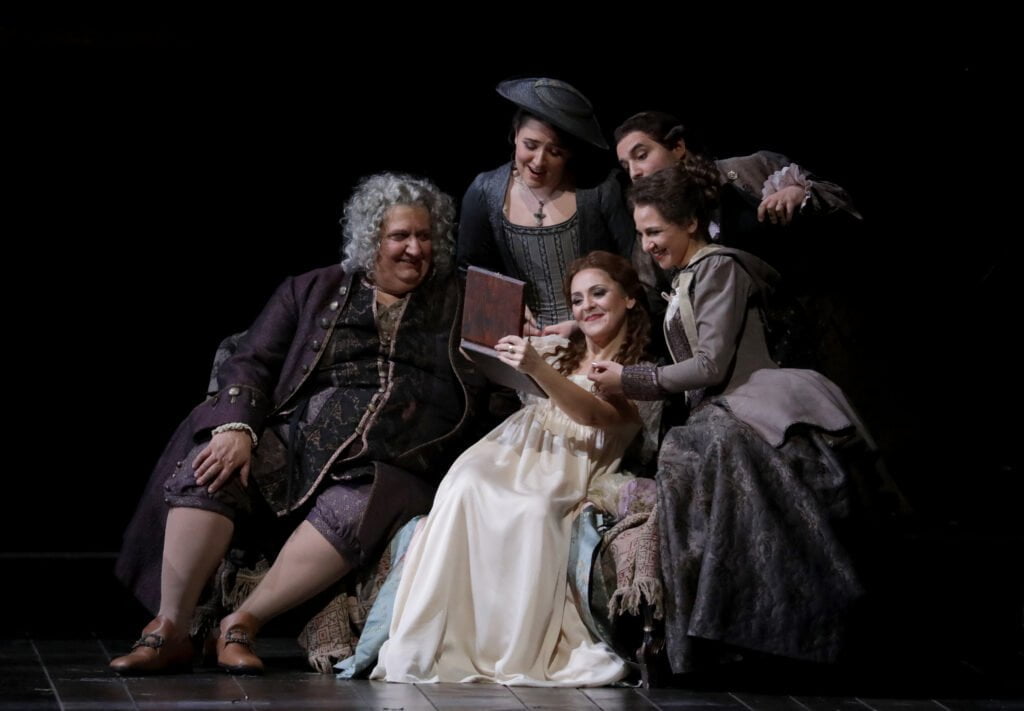
In the scenography created by Charles Edwards, the stage is almost entirely occupied by a construction that represents a sort of “theater within the theater” in the most literal sense of the word: in the First Act we see the back of a stage, on which the artists come and go before the start of the show, while the action takes place almost in the proscenium (dominated by a bust of Moliere in the foreground), where we see the costume racks, the stage manager’s table and the various dressing rooms, including the one where the “diva” will come out, and where Maurizio will arrive.
The finale of the opera also takes place at the foot of this stage, as if to underline how Adriana’s personal story cannot exist separately from her identity as an artist.
It is no coincidence that the same solution is adopted by director Italo Nunziata in the new co-production of the Piacenza and Modena theaters. Adriana lives and dies in her theater.
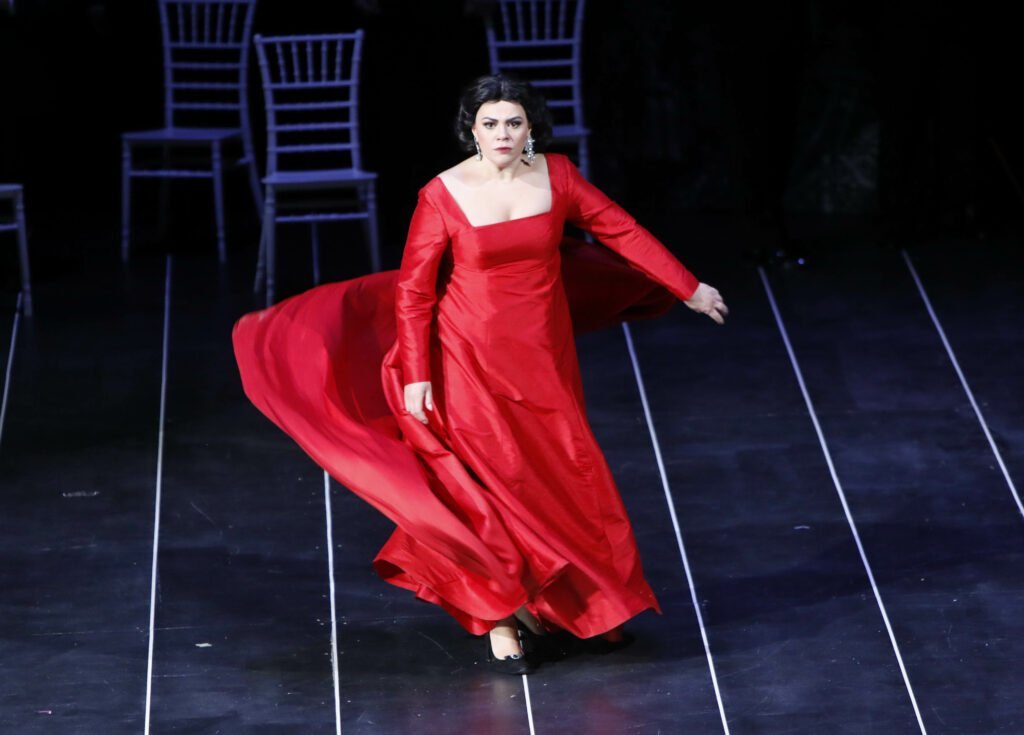
In this production the setting is transposed to the mid-twentieth century, a choice that, in our opinion, is decidedly difficult to justify, especially since in many points of the opera it clashes in a very evident way with the text of the libretto. Although the Bastille is abolished (sadly, slight changes to the libretto are increasingly allowed…), replaced by a generic “prison”, the queen, the cardinal, the heroic pretender to the throne, the king of Poland, the Russian Mencikoff, the threatened or alleged duels are difficult to place in a context of the Fifties. Nevertheless, an accurate direction, which essentially follows the original story with almost absolute fidelity, and which makes use of an essential but effective scenography, (often suggesting, rather than “showing”), makes the show acceptable, and indeed even enjoyable, once you are resigned to seeing Maurizio in a light-blue uniform (Navy or Air Force? We remain in doubt), in a tuxedo or in a pinstripe suit and a camel coat thrown over his shoulders in The Godfather style.
Particularly successful, in our opinion, is how Italo Nunziata solves the thorny problem of the confrontation between the two women in love with the Count. Making credible the fact that the two rivals cannot see and recognize each other is not at all easy. In fact, even in McVicar’s overall excellent direction, the two protagonists, who walk back and forth without seeing each other on the theoretically dark stage, (but who are actually, for obvious reasons, illuminated, albeit faintly) even borders on the ridiculous. Instead, Italo Nunziata cleverly solves the problem with the simple solution of equipping the two women with veils that hide their faces.
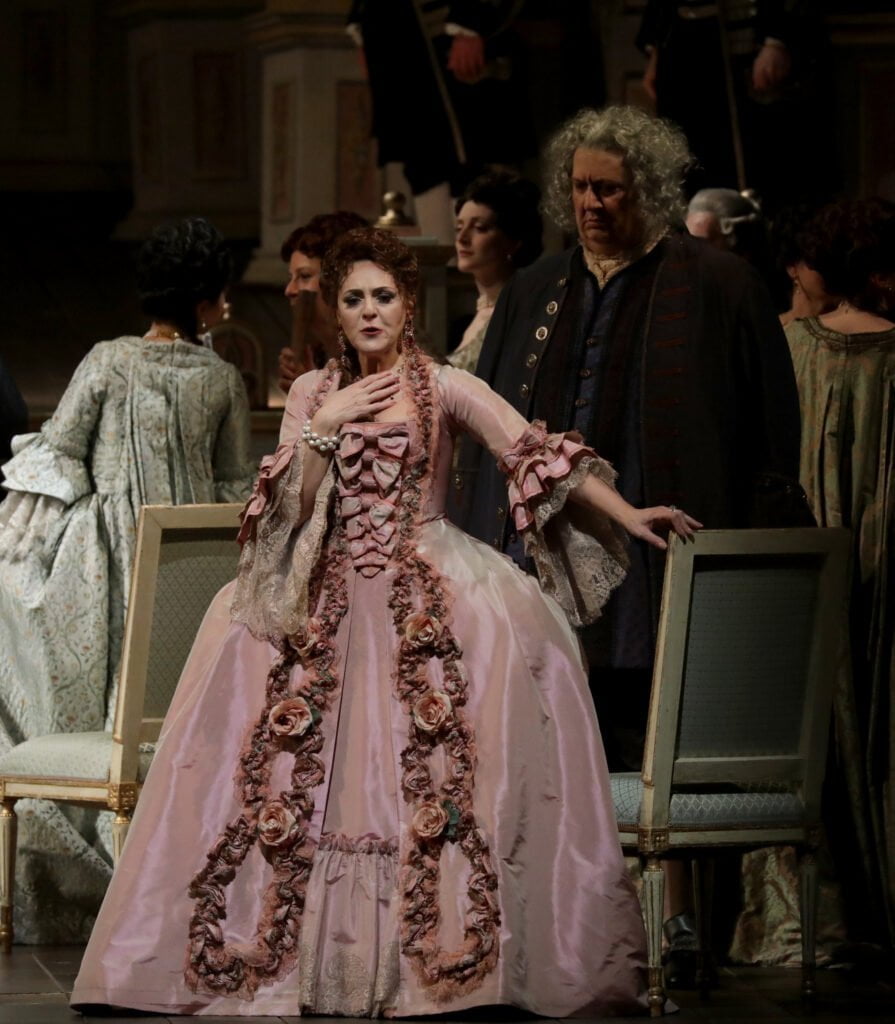
The comparison between the two casts is more complex. It must be said, first of all, that, as often happens now, especially in some theaters, the so-called Italian “Provincia” has been regaining, in recent years, that absolute dignity that made it, in the golden age of opera, a prestigious “training place” where the greatest singers of the time performed, often on the occasion of a debut. So the cast of Piacenza / Modena has no reason to envy La Scala.
First of all, the two Adrianas – Maria Agresta at La Scala and Maria Teresa Leva in Piacenza – who were both debutants in the role, pleasantly surprised us. In both cases, we were afraid that Adriana’s role was too “strong”, too dramatic for their vocal and theatrical characteristics. Undoubtedly, both will still have to “mature” the role, and perhaps both voices are not the ideal ones for the character. But their performances have been evolving, and they have managed, above all, to give life to two different but really engaging Fourth Acts. A further pleasant surprise was the difficult Monologue of Phaedra, recited, especially by Leva, with the authentic grit of a prose actress.
Their two rivals were also equally matched. We already knew and appreciated Judit Kutasi (last-minute replacement for Anita Rachvelishvili), and we were certainly not surprised by her Princess: proud, authoritarian, and passionate. We had never heard Teresa Romano, however, and to discover an Italian artist with a real mezzo-soprano voice (a critic friend of ours likened her to Fedora Barbieri, and we believe he is not at all wrong) was, for us, a great and beautiful surprise.
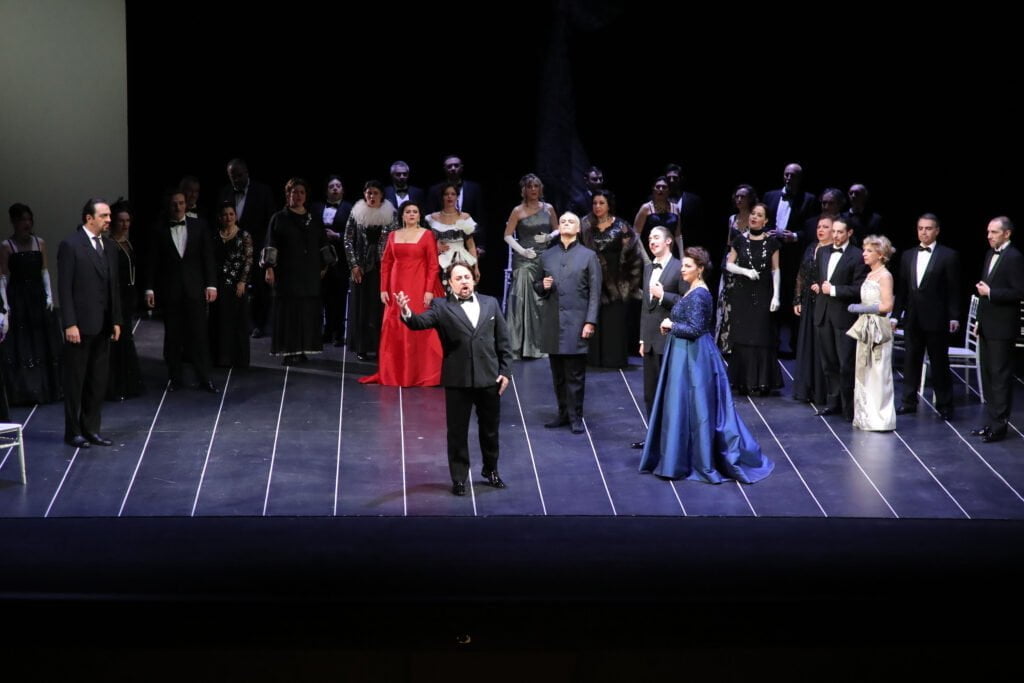
Between the two Michonnets, we must admit that we have a favorite, and he is Ambrogio Maestri, who played the role at La Scala. Much depends, however, on our personal vision of the character, who we like to imagine as middle-aged, tender, meek, resigned and defeated. Perhaps also due to the director’s different “reading”, Claudio Sgura, with his basketball player physique and his dark and powerful voice, was not as able to move us, although we gladly acknowledge that he sang well, in particular his aria, “Ecco il monologo” (“Here is the monologue”), and, in addition, he moved across the stage with great ease.
Last but not least, we come to the crucial point of our commentary: the comparison between the two Maurizios. We had never heard Yousif Eyvazov live, and we were understandably curious since, honestly, we had never understood why he is in the cast of all the biggest theaters in the world. We were at pains to think of an explanation, barring the most obvious one, and the performance we watched failed to enlighten us any further. He obviously is an intelligent artist, who knows what he’s doing, and valiantly tried to be Maurizio. But technically, his voice features an unpleasant vibrato, as well as a bland vocal color that produces rather dull high notes, without “smalto,” as we say in Italian. It is commonly agreed that Eyvazov’s voice is “ugly,” but we are personally convinced that – although there are undoubtedly voices “kissed by nature” – no technically educated voice produces ugly sounds. So, in our opinion, the shortcomings are mainly technical.
In Piacenza, we heard Luciano Ganci in the role of the protagonist, and not for the first time. So we have truly little to add to what we wrote about him a few months ago, when reviewing Adriana Lecouvreur in Bologna. Our comment is analogous, but opposite to the one we made above. Ganci’s voice is undoubtedly beautiful by nature, but nature matters little if it is not supported by a technique that makes it possible to draw a musically complex character like Maurizio. Passionate, insinuating, determined and, if necessary, Gascon (his “Russo Mencikoff” is, in our opinion, from an anthology), Ganci shows off sparkling high notes, but also refined pianissimo in “L’anima ho stanca” and in the finale (“No, più nobile sei delle regine” etc.).
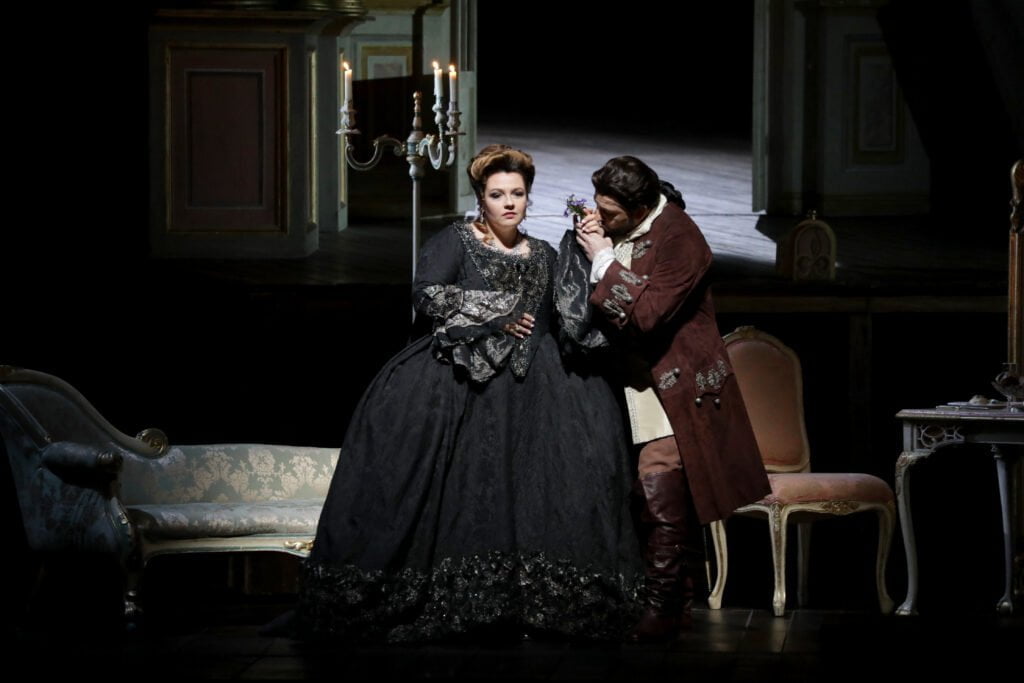
On the whole, we can be satisfied with both casts. As for the interpreters of the minor roles, we will limit ourselves to saying that, musically, both performances seemed valid to us. Lively, delicate, intense according to need, with perhaps, from a director from the “old school” like Aldo Sisillo, a special attention to singers. We noticed, instead, not for the first time, that the la Scala orchestra tends to play “too loud”, sometimes putting the stage in difficulty.
We still wish to make a final observation regarding the choreography of the ballet, “The judgment of Paris”. Under McVicar’s direction, the ballet, following the subject accurately described by the libretto, adapts perfectly to the music, deliberately rich in eighteenth-century suggestions. On the other hand, we didn’t like Danilo Rubeca’s modern choreography at all, which at times could almost pass as a gymnastics performance. We found it decidedly ugly and out of place, ungraceful (without fault, of course, of the performers), devoid of recognizable meaning and completely detached from the music.
